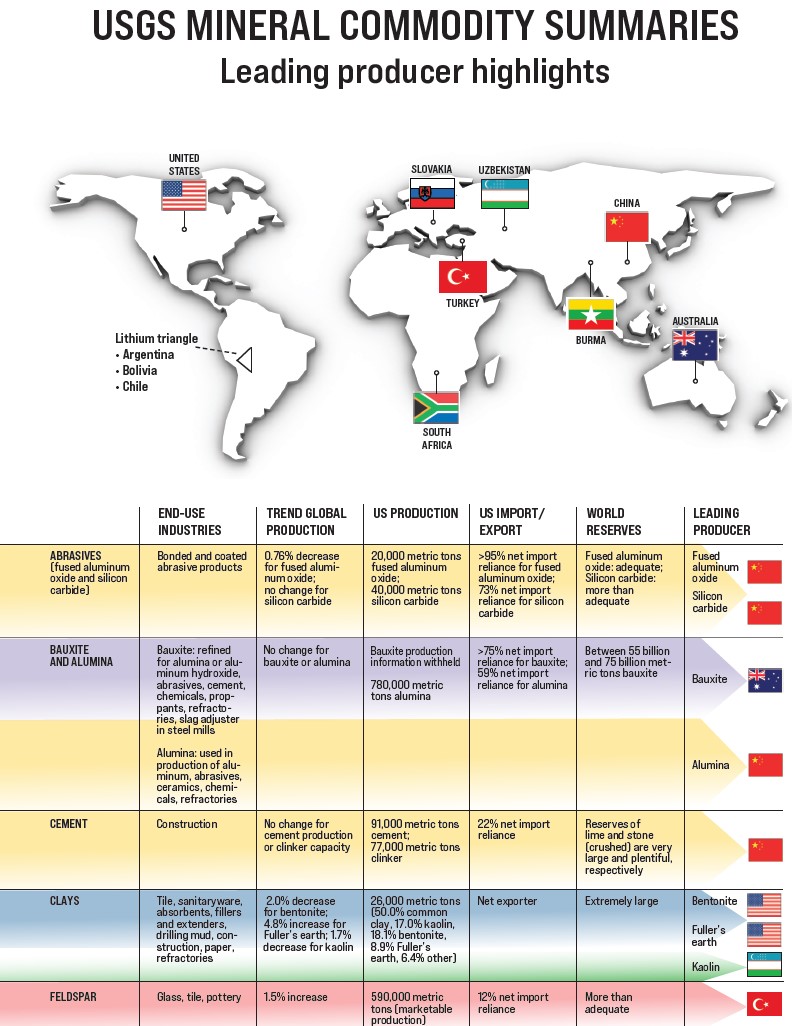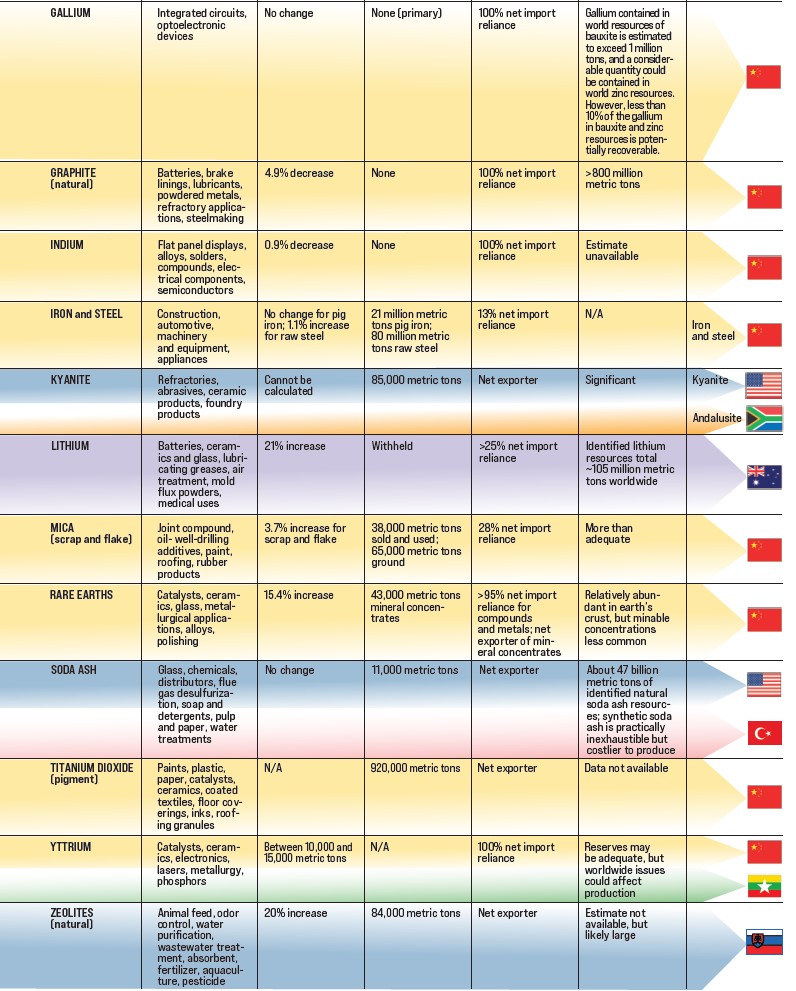The U.S. government has progressed to the next stage of its plans to strengthen domestic supply chains, as described in the annual United States Geological Survey Mineral Commodity Summaries.1
The USGS Mineral Commodity Summaries report spotlights events, trends, and issues from the past year in the nonfuel mineral industry. Every August, the ACerS Bulletin shares some of the key facts covered in the report, including statistics on production, supply, and overall market for more than 90 minerals and raw materials.
In 2023, the total value of nonfuel mineral production in the United States was estimated to be $105 billion, an increase of 4% from $101 billion in 2022. The total value of industrial minerals production was $69.9 billion, an increase of 7% from 2022. Of this total, $35.2 billion came from construction aggregates production. Crushed stone accounted for the largest share of total U.S. nonfuel mineral production value in 2023 with 23%.
Operational issues, reduced ore grades, and weather-related issues caused a decrease in production for the metals sector. On the flip side, increased demand for aggregates caused an increase in production value for the industrial minerals sector.
Following two years of focused efforts to update the U.S. Geological Survey’s critical minerals list and establish funding avenues to support an expansion of the domestic mining sector, the U.S. government has now started investing in numerous mineral exploration and feasibility surveys and nascent mining projects.
For example, in February 2023, the USGS Earth Mapping Resources Initiative launched the “National Map of Focus Areas for Potential Critical Mineral Resources in the United States,” which outlines focus areas of mineral systems and their deposits around the country. Throughout 2023, the U.S. government invested $22.3 million across Alabama, Alaska, Arizona, Montana, New Mexico, New York, and Utah to map resources of critical minerals in those states.
Meanwhile, regarding mining projects, in July 2023, the U.S. Department of Energy announced $32 million in funding to support the construction of facilities that produce rare earth minerals and other critical metals to help alleviate reliance on international sources.2
Notably, in November 2023, production was restarted at a high-purity granular polysilicon facility in Washington state, which had not been active in four years. The material produced here will then go to a facility in Georgia that produces silicon ingots, wafers, and cells for solar module production. Solar-grade wafers have not been produced in the U.S. since 2016, so this effort should also help alleviate reliance on foreign sources.
It will take several years to reap the benefits from the projects described above, so for now, the U.S. remains reliant on foreign sources for raw and processed mineral materials. In 2023, the U.S. was 100% net import reliant for 12 of the 50 individually listed critical materials and was more than 50% net import reliant for an additional 29 mineral commodities.
As in 2022, recycling provided the only source of domestic supply for antimony, bismuth, chromium, germanium, tin, tungsten, and vanadium. In 2023, the consumption of many mineral commodities decreased compared to the previous year.
With these programs and initiatives in place to help bolster domestic production, the U.S. government is now taking a more direct stance in its trade war against China. In May 2024, the U.S. announced new Section 301 import tariffs, including one on rare earth magnets.3 This tariff is the first time that a Section 301 import tariff has been imposed on rare earth materials since the U.S.–China trade and technology war began in 2018.
These tariffs may be a boon for Wyoming, which hosts a plentiful supply of rare earth minerals. Several rare earth minerals companies are already operating in the state, and these tariffs provide them the opportunity to penetrate the rare earths market and regain equal footing with suppliers in China.4
On the next two pages, a table summarizes some of the salient statistics and trends for a handful of mineral commodities that are of particular interest in the ceramic and glass industries.
Access the complete USGS report at https://doi.org/10.3133/mcs2024.


Cite this article
H. Widman, “US takes next steps in domestic mining expansion with feasibility surveys and projects,” Am. Ceram. Soc. Bull. 2024, 103(6): 27–29.
Issue
Category
- Art, archeology, and conservation science
- Energy materials and systems
Article References
1Mineral Commodity Summaries 2024, U.S. Geological Survey, Reston, Va., 2024.
2“Biden-Harris Administration invests $32 million to strengthen nation’s critical minerals supply chain,” Department of Energy, 13 July 2023.
3“US to impose 25% import tariffs on Chinese rare earth magnets in 2026,” Fastmarkets, 15 May 2024.
4“Wyoming’s rare earths industry may see boost from Chinese tariffs on imports,” Cowboy State Daily, 14 May 2024.
Related Articles
Market Insights
Lessons learned from the rollout of 5G technology help guide 6G preparations
While it may seem like the 5G communications and data network has just been rolled out—and is, in fact, still in the process of being deployed—communications providers, governments, and researchers are already preparing for the sixth generation of wireless technology, or 6G. Compared to 5G, which aimed to expand the…
Bulletin Features
The synthetic data revolution: How AI is redefining quality control in ceramics manufacturing
The ceramics industry stands at the brink of a fundamental shift in how quality control is conceived, implemented, and scaled. For decades, the promise of artificial intelligence-powered inspection systems was held back by a persistent obstacle: the scarcity of high-quality data. This bottleneck made it difficult for ceramics manufacturers to…
Market Insights
Global edge AI market
The global market for edge artificial intelligence was valued at $8.7 billion in 2024 and is expected to grow at a compound annual growth rate (CAGR) of 36.9% to reach $56.8 billion by the end of 2030. Edge computing refers to data processing that occurs closer to where the data…





